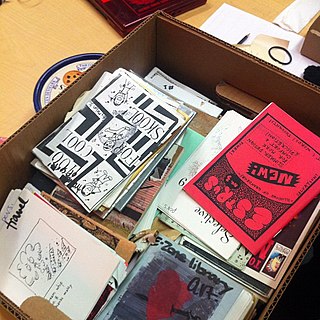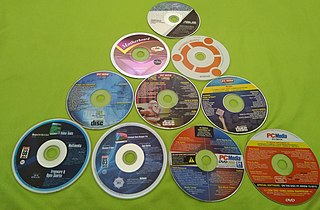
ASCII art is a graphic design technique that uses computers for presentation and consists of pictures pieced together from the 95 printable characters defined by the ASCII Standard from 1963 and ASCII compliant character sets with proprietary extended characters. The term is also loosely used to refer to text-based visual art in general. ASCII art can be created with any text editor, and is often used with free-form languages. Most examples of ASCII art require a fixed-width font such as Courier for presentation.

A fanzine is a non-professional and non-official publication produced by enthusiasts of a particular cultural phenomenon for the pleasure of others who share their interest. The term was coined in an October 1940 science fiction fanzine by Russ Chauvenet and first popularized within science fiction fandom, and from there the term was adopted by other communities.

A zine is a small-circulation self-published work of original or appropriated texts and images, usually reproduced via a copy machine. Zines are the product of either a single person or of a very small group, and are popularly photocopied into physical prints for circulation. A fanzine is a non-professional and non-official publication produced by enthusiasts of a particular cultural phenomenon for the pleasure of others who share their interest. The term was coined in an October 1940 science fiction fanzine by Russ Chauvenet and popularized within science fiction fandom, entering the Oxford English Dictionary in 1949.

Factsheet Five was a periodical mostly consisting of short reviews of privately produced printed matter along with contact details of the editors and publishers.

The demoscene is an international computer art subculture focused on producing demos: self-contained, sometimes extremely small, computer programs that produce audiovisual presentations. The purpose of a demo is to show off programming, visual art, and musical skills. Demos and other demoscene productions are shared, voted on and released online at festivals known as demoparties.
Maximumrocknroll, often written as Maximum Rocknroll and usually abbreviated as MRR, is a not-for-profit monthly online zine of punk subculture and radio show of punk music. Based in San Francisco, MRR focuses on punk rock and hardcore music, and primarily features artist interviews and music reviews. Op/ed columns and news roundups are regular features as well, including submissions from international contributors. By 1990, it "had become the de facto bible of the scene". MRR is considered to be one of the most important zines in punk, not only because of its wide-ranging coverage, but because it has been a consistent and influential presence in the ever-changing punk community for over three decades. From 1992 to 2011, it published a guide called Book Your Own Fuckin' Life.
Profane Existence is a Minneapolis-based anarcho-punk collective. Established in 1989, the collective publishes a nationally known zine, as well as releasing and distributing anarcho-punk, crust, and grindcore music, and printing and publishing pamphlets and literature. Stacy Thompson describes the collective as "the largest, longest-lasting, and most influential collective in Anarcho-Punk so far." The collective folded in 1998, although its distribution arm, then called Blackened Distribution, continued operating. It restarted in 2000. "Making punk a threat again" is the group's slogan.

The Kosmic Free Music Foundation was a worldwide group of computer musicians, artists, and coders focused on the PC demoscene. Most members were from the United States, Canada, and Australia. They created music—mostly techno, trance, and ambient—with tracker software. They also created some artwork and demos. All their productions were available to download without charge from BBSes and the internet. In the 1990s, they were known for having many of the tracking scene's top musicians as members. Their early presence on the Internet made them one of the first netlabels. The leader of Kosmic was Dan Nicholson, who went by the alias Maelcum.

Famitsu, formerly Famicom Tsūshin, is a line of Japanese video game magazines published by Kadokawa Game Linkage, a subsidiary of Kadokawa. Famitsu is published in both weekly and monthly formats as well as in the form of special topical issues devoted to only one console, video game company, or other theme. Shūkan Famitsū, the original Famitsu publication, is considered the most widely read and respected video game news magazine in Japan. From October 28, 2011, the company began releasing the digital version of the magazine exclusively on BookWalker weekly.

The Warez scene, often referred to as The Scene, is a worldwide, underground, organized network of pirate groups specializing in obtaining and illegally releasing digital media for free before their official sale date. The Scene distributes all forms of digital media, including computer games, movies, TV shows, music, and pornography. The Scene is meant to be hidden from the public, only being shared with those within the community. However, as files were commonly leaked outside the community and their popularity grew, some individuals from The Scene began leaking files and uploading them to filehosts, torrents and ed2k.

Covermount is the name given to storage media or other products packaged as part of a magazine or newspaper. The name comes from the method of packaging; the media or product is placed in a transparent plastic sleeve and mounted on the cover of the magazine with adhesive tape or glue.

XLR8R is a website that covers music, culture, style, and technology. It was originally also a print magazine.

A disk magazine, colloquially known as a diskmag or diskzine, is a magazine that is distributed in electronic form to be read using computers. These had some popularity in the 1980s and 1990s as periodicals distributed on floppy disk, hence their name. The rise of the Internet in the late 1990s caused them to be superseded almost entirely by online publications, which are sometimes still called "diskmags" despite the lack of physical disks.
British small press comics, once known as stripzines, are comic books self-published by amateur cartoonists and comic book creators, usually in short print runs, in the UK. They're comparable to similar movements internationally, such as American minicomics and Japanese doujinshi. A "small press comic" is essentially a zine composed predominantly of comic strips. The term emerged in the early 1980s to distinguish them from zines about comics. Notable artists who have had their start in British small press comics include Eddie Campbell, Paul Grist, Rian Hughes, Jamie Hewlett, Alan Martin, Philip Bond and Andi Watson.

Hugi is one of the longest lasting, frequently released demoscene and underground disk magazines (diskmag) for IBM-PC.
Fanorama is a Rhode Island-based zine and zine-distro produced by journalist/activist REB. According to their website it is the "grand-daddy of the queer zine scene".
European Top 20 was a disk magazine and scene chart for the Commodore Amiga published by the demo scene group Equinox. The first issue was published in July 1992 and the last in July 1993.
Jakarta Mail is a Jakarta EE API used to send and receive email via SMTP, POP3 and IMAP. Jakarta Mail is built into the Jakarta EE platform, but also provides an optional package for use in Java SE.
James Sutton, known as Jam Sutton, is an English visual artist.









